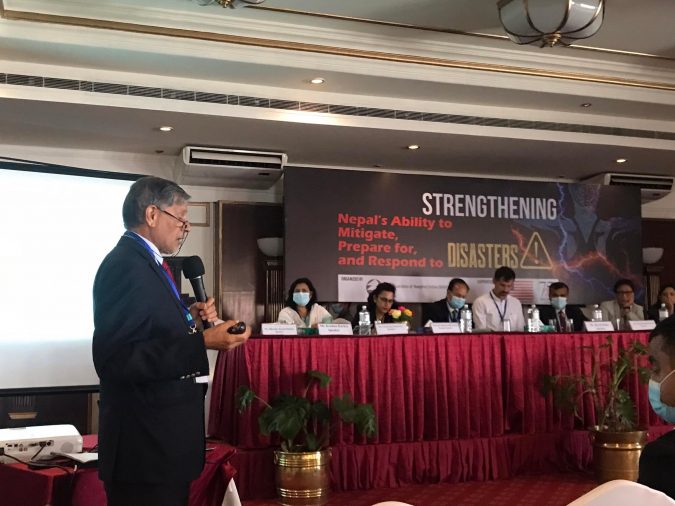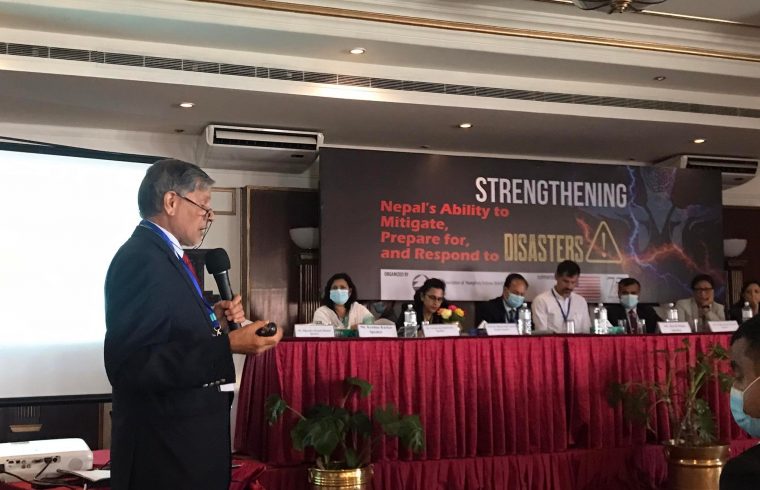Kathmandu- Nepal Association of Humphrey Fellows (NAHF) has organized a program “Strengthening Nepal’s Ability to Mitigate, Prepare for, and Respond to Disasters” on Monday in Kathmandu.
More than fifty experts gathered at the program and raised questions about the government’s action-related hazard monitoring and implementation program.

The experts alerted the government officials to the alarming situation of the next earthquake disaster in Nepal. They also addressed not only affecting future earthquakes but directly exposing climate change in the Nepal Himalayas, which leads to multiple hazards.
According to the data, Nepal is ranked as one of the 20th most vulnerable countries in the world. The country is ranked 4th, 11th, and 30th in terms of climate change, earthquake, and flood risk, respectively.
There are other major disasters, listed by the government of Nepal, such as landslides, fires, droughts, epidemics, storms, hailstorms, avalanches, and GLOF.
A keynote speaker, Prof. Bisal Nath Upreti, Ph.D., Geologist, Former Dean of Science and Technology Faculty, Tribhuvan University, Nepal, says, “We don’t need more research on disasters but need quick action right now. It’s too late to take action on disaster preparedness in the country.”
Prof. Upreti said that one of the future earthquakes has not come yet, but it will definitely come with the magnitude of the 1990 B.S. (1934 A.D.) earthquake. That’s why we need to install an additional Earthquake Early Warning System (EEWS) very soon. “Nepal has only one EEWS installed by a Chinese company at the Nepal Academy of Science and Technology (NAST).”Nowadays, EEWS hasn’t worked properly due to technical and lack of funds,” he says.
According to Prof. Upreti, the Great Nepal-Bihar earthquake occurred on 15th January 1934 A.D., which is one of the worst earthquakes in the history of Nepal. The epicenter was located in eastern Nepal, about 9.5 km south of Mount Everest. So we need to figure out earthquake preparedness and be ready to tackle it in the future, he urges. “We want to continue the National Earthquake Early Warning System (NEEWS) in the near future, which helps to alert people 30 seconds before coming to S-wave.” It is due to P-waves traveling fastest and feeling people first arriving from the earthquake.
According to the National Disaster Risk Reduction Portal, 1,205 people died due to landslides and floods in the last decade. In Nepal, landslides and floods are caused by heavy rainfall during the monsoon period from June to September, an official says.
Dr. Archana Shrestha, Deputy Director General, Department of Hydrology and Meteorology (DHM) says, “Due to upgraded technology, meteorological forecasting is better now–but—in-route domestic forecasting in aviation is still a problem.” In the beginning, weather forecasting was a neglected subject, but now the government and other international institutions have supported DHM to strengthen their capacity, she added.
The role of early preparation of monsoon by householders in rural areas to be used is an ancient technique in March-April when they collect straws and maintain roofs, explains Ms. Krishna Karki, humanitarian and development professional at Disaster Risk Reduction and Humanitarian Response (DRR). But unfortunately, this ancient technique has not been followed by villagers.
Mr. Pradip Kumar Koirala, Joint Secretary, Ministry of Home Affairs said that people have satisfied with our work because they used to say why didn’t stop landslides after being rescued from the affected area. According to the constitution of Nepal, the local government has played a vital role in disaster-prone unfortunately not having this, he added.
According to government officials, the number of deaths has decreased due to the increase in the number of SMS alerts and early warning systems in flood-affected areas.
Ms. Sanchita Neupane, ECHO DRR Program Manager, People in Need (PIN) said that seven percent of landslides occur due to the construction of new roads in hilly areas.
Ms. Yam Kumari Khatiwada, Former Secretary, Government of Nepal (GoN), has said that the GoN’s failure to upgrade universities can help with the necessary knowledge for development, but such things are missing in the country.
“I have heard about the charging system for those who are not following the government’s disaster management system. It’s not a reliable and good system,” Mr. Dipendra Purush Dhakal, Former Governor, NRB & Former Secretary, Government of Nepal, says. People are very crazy about their own homeland, and they always want to live in their ancestors’ homeland. It is acknowledged to be better than changing people.
Dr. Meen B. Poudyal Chettri highlighted the program, which was chaired by Mr. Deependra Biram Thapa, President, NAHF.








